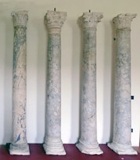

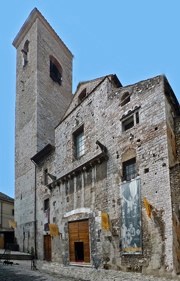
This church, which was perhaps the first Duomo of Narni, is reputed to have been built on the site of a Roman temple of Minerva. Pope Eugenius III consecrated it to Santa Maria Maggiore in 1148. It was re-dedicated to San Domenico in 1303 when it passed to the Dominicans, who had settled outside the city in 1253.
The convent was damaged in 1527 when Imperial soldiers sacked Narni. Cardinal Giuseppe Sacripanti remodelled the interior of the church in 1715, and it was re-consecrated in 1728.
The church and convent were put to secular use in the Napoleonic period, and suffered further indignities when they passed to the Commune in 1867. A number of works of art that were removed thereafter are now the Pinacoteca (see below).
In 1979, a room was re-discovered under the apse that was used by the Inquisition in the 17th and 18th centuries - see the page on the adjacent subterranean church of Sant’ Angelo.
The complex was restored in the 20th century as an auditorium and a home for the public library and archives. It was restored again and recently re-opened as an auditorium (2011).
Exterior

The façade was rebuilt in the 13th century, to the right of the enormous campanile. There are sculptures of human and animal heads under the cornice above the main portal.
Portal (12th century)

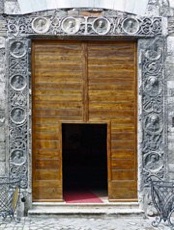
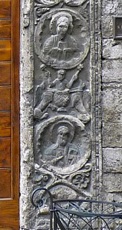
This portal, which came from the original facade, has reliefs of the Apostles in tondi on the architrave and the jambs.
-
✴The cross at the centre of the architrave has crouching figures to the sides.
-
✴The relief between the lowest two tondi on the right jamb shows a figure in a chariot that is drawn by griffins. These mythical animals drew the chariots of Apollo and of Nemesis, as well as that of Alexander the Great as he tried to ascend into Heaven.
Interior
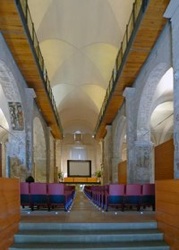
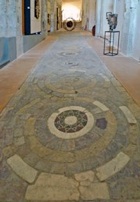
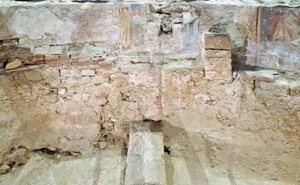
The Dominicans demolished the original semi-circular apse, probably in the 14th century, and built the present apse and flanking apsidal chapels. The foundations of the original apse, with traces of frescoes, were uncovered in the recent restoration.
The side chapels were added in the 15th and 16th centuries. The 4th chapel on the right belonged to the Gattamelata family.
Sculpture (15th century)
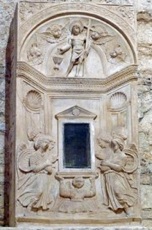
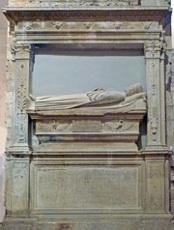
There are interesting works of sculpture on the inside surfaces of the pilasters at the end of the nave:
-
✴the marble tabernacle on the right is by a follower of Agostino di Duccio (illustrated on the left above); and
-
✴the monument of Gabriele Massei (1494) on the left has an inscription that says that the deceased was snatched away in the flower of his youth (illustrated on the right above).
Crucifixion (14th century)
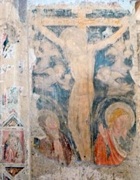
Crucifixion (14th century?)
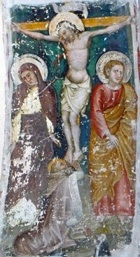
Frescoes on the Counter-facade (ca. 1400)
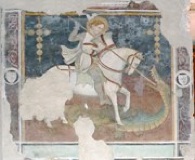
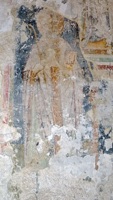
These frescoes, which are attributed to the Maestro di Narni del 1409, depict;
-
✴St George and the dragon (to the left of the portal); and
-
✴St Hugo enthroned (to the right of the portal).
Madonna and Child with saints (15th century)
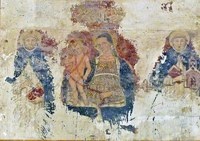
This fresco in the apsidal chapel at the end of the left aisle, which is by a follower of Pier Matteo d’ Amelia, depicts the Madonna and Child with SS Dominic and Thomas Aquinas.
Virgin and St Lucy (15th century)
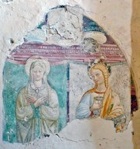
Frescoes in the Right Apsidal Chapel (16th century)
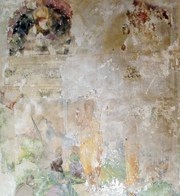
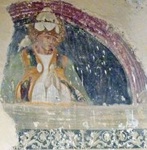
These damaged frescoes have been recently attributed to Giovanni Francesco Perini.
-
✴Those on the right wall, which are still in situ (illustrated above), albeit that they are badly damaged, depict:
-
•the Resurrection; and
-
•SS Augustine and Ambrose, in the lunettes above.
-
✴Those on the left wall depicted:
-
•the Last Supper; and
-
•SS Jerome and Gregory the Great, in the lunettes above.
-
Most of these have been detached and partly survive in the Pinacoteca (see below). Only the figure of St Gregory (illustrated above) survives in situ.
-
✴The frescoes on the back wall, which have been completely lost, presumably included a scene of the Crucifixion.
Frescoes (16th century)
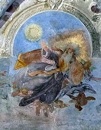
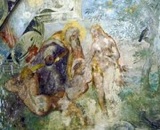
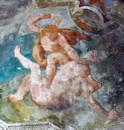
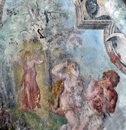
These damaged frescoes, which are attributed to Johann Marten Stellaert and Gillis Congnet, are in the vault of the Cappella del Rosario (the large chapel on the left). The inscription giving the date, which was documented in 1872, is no longer legible. The surviving frescoes depict:
-
✴scenes from Genesis, in the vaults (details of which are illustrated above); and
-
✴the Annunciation, on the right wall.
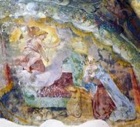
Art from the Church
In 1523, Cardolo dei Cardoli, the Prior of the Società delle Suore del Rosario commissioned from Rinaldo Jacovetti da Calvi an altarpiece of the Assumption of the Virgin, surrounded by scenes of the mystery of the Rosary, for Santa Maria Maggiore (now San Domenico). This work has been lost.
Works in the Pinacoteca
The following works, which were removed when San Domenico passed to the ownership of the Commune in 1867, are now in the Pinacoteca.
Processional Banner (ca. 1400)
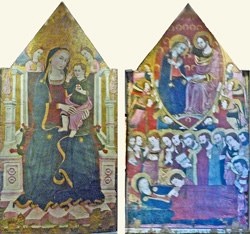
This double-sided panel, which is attributed to the Maestro di Narni del 1409, seems originally to have served served as a processional banner. It was first recorded in 1872 in the sacristy of San Domenico, although this was not necessarily its original location. It was restored in 1989. The panel depicts:
-
✴the Madonna and Child enthroned; and
-
✴the Dormition of the Virgin, with her Coronation above.
Three Angels (ca. 1400)
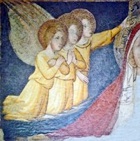
Annunciation (ca. 1450)
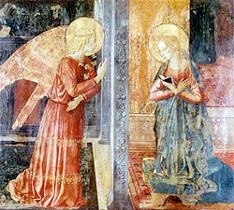
This signed altarpiece by Benozzo Gozzoli was restored in 1988. The foliage on the painted architecture at the centre of the composition is reminiscent of that on the Eroli arms, and it is possible that Cardinal Berardo Eroli was associated with the commission. The panel, which was recorded in 1872 in the second chapel on the left of the church, was most recently restored in 2002.
[This work was once more in restoration in 2010]
Madonna and Child with saints (ca. 1540)
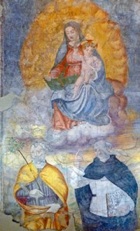
Last Supper (16th century)
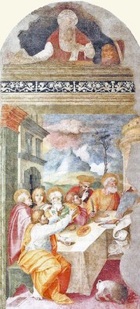
The detached frescoes depict:
-
✴the left part of a scene of the Last Supper, with six of the disciples, including St Peter, brandishing a knife, and Judas, immediately behind him; and
-
✴St Jerome and his lion in the lunette above.
Capitals (12th century)
